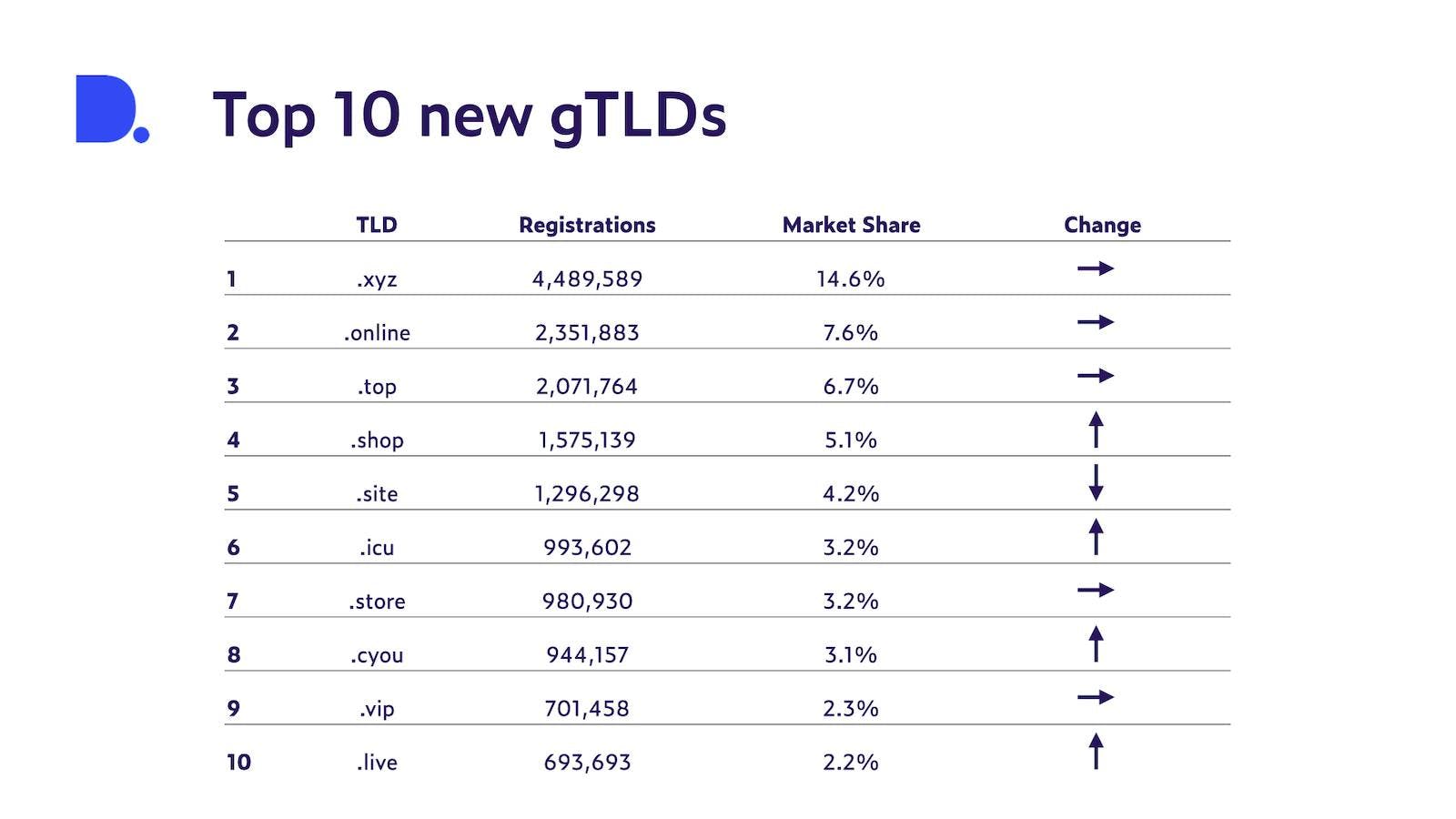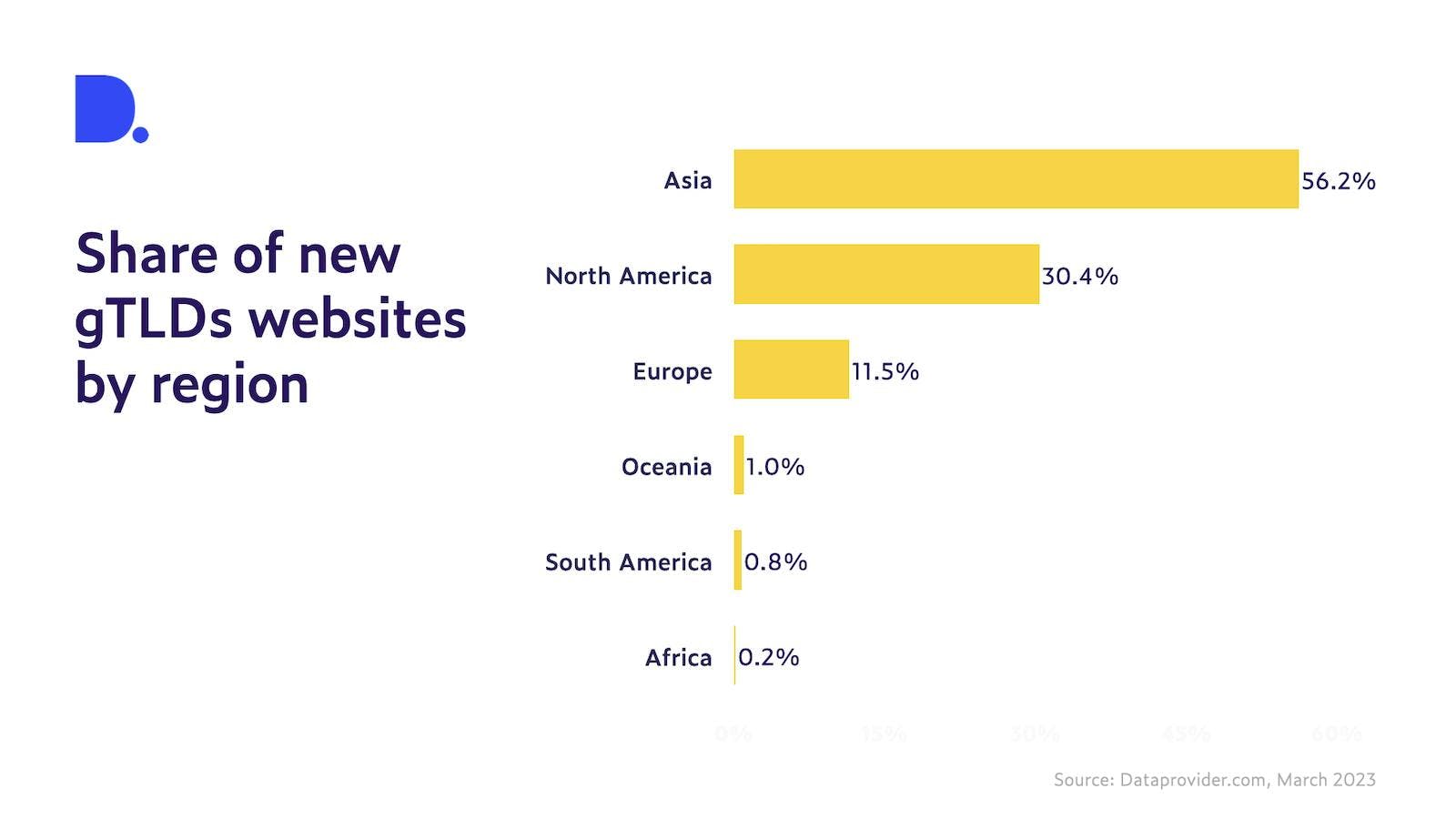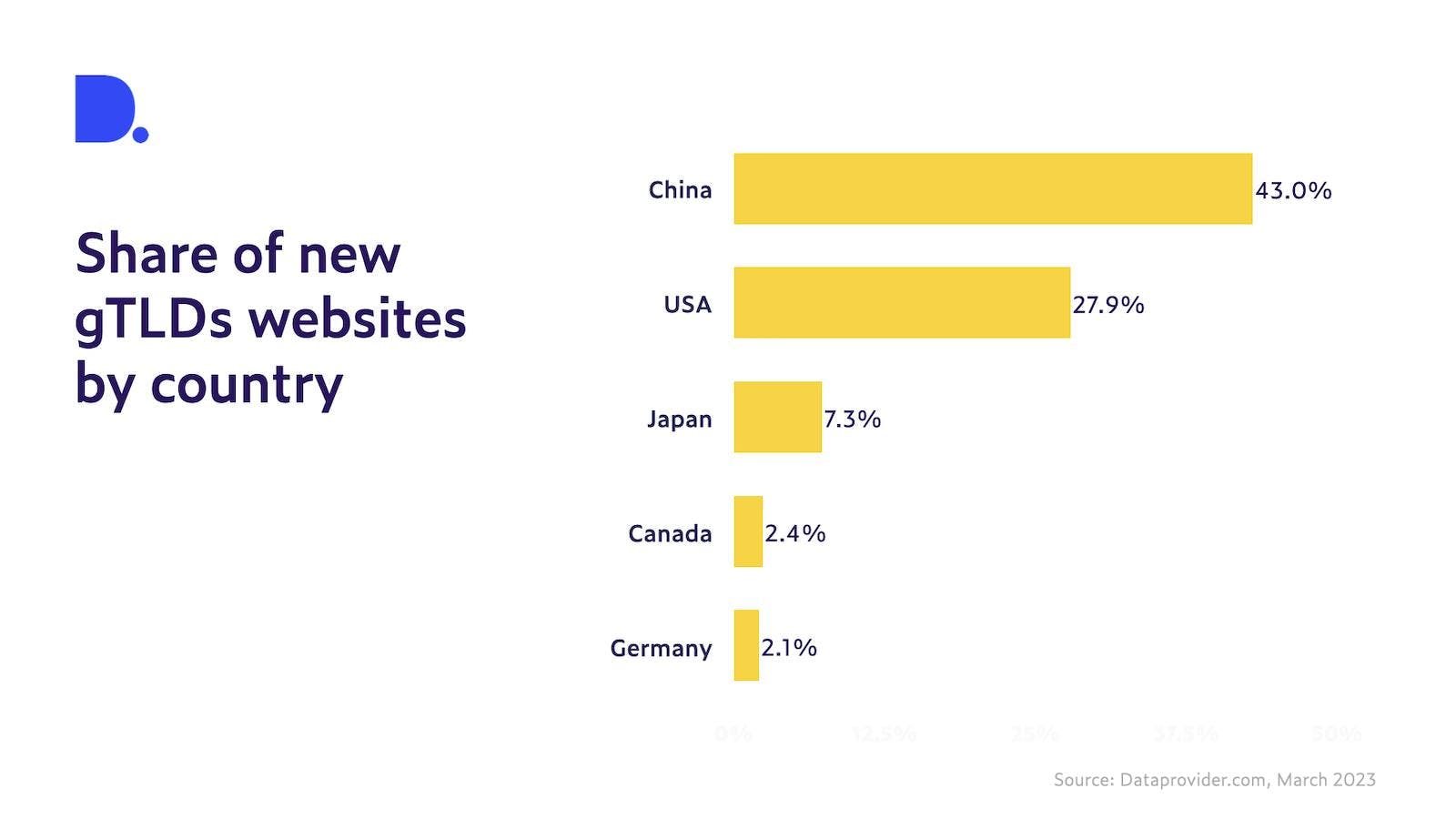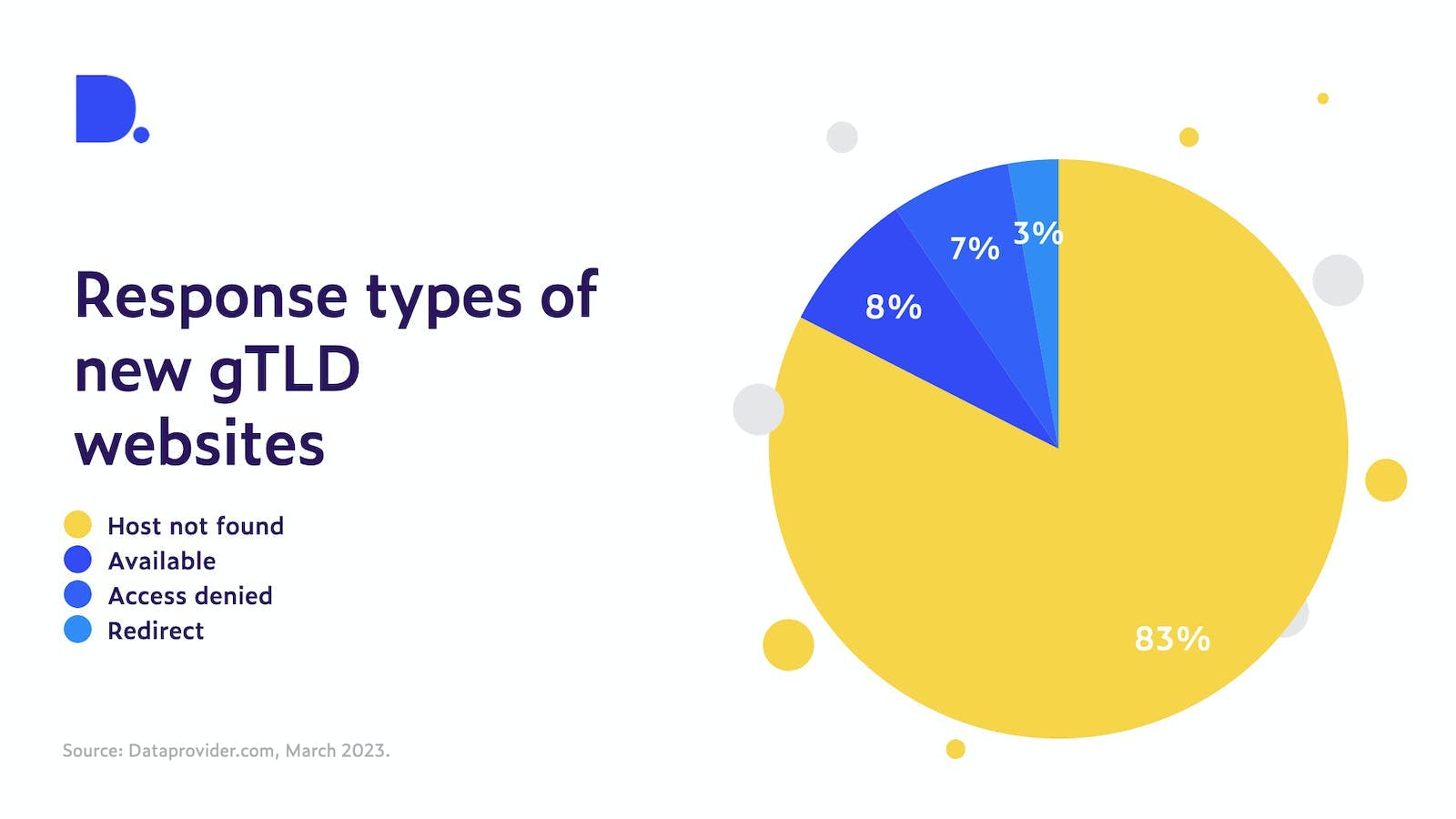Who, where, how: the 10 most frequently registered new gTLDs
- about 2 years ago
- 6 min read
Which are the most registered new gTLDs worldwide? Who uses them? And where are websites under this TLD category located? Let's look at the current situation in 2023.
When the internet was first conceptualized, the only top-level domain (TLD) available was .arpa. However, as the internet began to gain popularity and the number of websites grew rapidly, the need for more TLDs arose. In 1985, five TLDs were introduced, namely .com, .edu, .gov, .mil, and .org. These so-called legacy TLDs became the foundation for today's domain name system (DNS). However, with the explosion of the internet and digitalization, there has been a growing demand for more TLDs to accommodate the ever-increasing number of websites and online services. In 2012, the Internet Corporation for Assigned Names and Numbers (ICANN) launched the first new generic top-level domain program. As a result, hundreds of new gTLDs have been added in recent years. A program for a second round of new gTLDs has already been announced and is set to increase the opportunities in the namespace even further.
New gTLDs have been around for a few years, becoming an increasingly popular option for website owners who want to stand out. What are the most popular new gTLDs today? The answer can be found in the Global Domain Report 2023, a comprehensive study of the domain industry conducted by InterNetX and Sedo supported by Dataprovider.com.

What are new gTLDs?
New generic top-level domains (new gTLDs) are extensions in the domain name system (DNS). They were introduced in 2014 to address the growing need for more domain name options, as the traditional ones like .com, .net, and .org were becoming increasingly saturated. With the launch of new gTLDs, businesses and individuals could start registering domain names that are more relevant, descriptive and memorable, enabling better online branding and differentiation. For example, if you run a pizza business, you can choose a domain name under the .pizza extension. Similarly, if you are in the fashion industry, you can choose a domain extension such as .fashion or .cfd or .style. If your business is located in the German capital, you could select a domain under .berlin, while .nyc is perfect as a city brand for New York. Such domain extensions help your website stand out from the crowd and indicate what your website is about or where it operates.
In summary, new gTLDs offer greater flexibility, creativity and branding opportunities for businesses and individuals to create a successful online presence. They are an exciting development in the domain name system that can help businesses and individuals stand out in a crowded online world.
Who uses new gTLDs?
In the ever-evolving landscape of the internet, new gTLDs emerged as a groundbreaking development that aimed to expand the DNS and offer more choice and flexibility for domain names. However, as with any novel concept, it took time for them to gain recognition and establish themselves as viable options in the online world. Today, digital-native brands are increasingly using their entire domain name as their brand name, including the extension. New gTLDs have been adopted, particularly in specific niche markets or innovative sectors, since they allow businesses to create meaningful connections with consumers through their visual identity. This is something that is otherwise not easily achieved due to the saturation of "traditional" TLDs. Despite the potential benefits, the general public's awareness of new gTLDs still needs to be enhanced. This can be attributed to several factors, such as the sheer number of new gTLDs introduced, the lack of mainstream adoption by high-profile businesses and the continued dominance of the more established domain extensions in popular culture and general discussions.
The new gTLDs category is in the process of carving out its place in the digital landscape. While niche markets and innovative brands have embraced these new extensions as their brand name or for targeted campaigns and creative marketing endeavors, major brands continue to depend on the tried-and-true legacy gTLDs and ccTLDs for their primary online presence, demonstrating that new gTLDs have yet to fully establish themselves as a mainstream choice.
These are the top 10 new gTLDs
The Global Domain Report, produced annually by InterNetX and Sedo, is an in-depth assessment of the domain industry. In its fourth edition, this year's report provides insights into the world of new gTLDs. Among the many exciting facts, it sheds light on the top 10 new gTLDs based on the number of domain registrations in 2023.

The new gTLD scene is broad and manifold. In 2022, the new gTLDs .icu and .cyou showed the highest growth year-over-year (yoy), while registrations under .vip dropped significantly. Among them all, there is one extension that has managed to create a significant market share for itself over the years, namely the TLD .xyz. The extension got its first boost in 2015 when Google registered abc.xyz for its holding company Alphabet Inc., bringing new gTLDs to the general public's attention. Today, the registry collaborates with blockchain, crypto and NFT players to establish itself as a leading TLD in the Web3 sector. This is well illustrated in the research "Crypto & NFT: an analysis of two trending keywords in domain names." The data shows a vigorous increase in domain names containing these keywords, with.xyz being the first new gTLD for this kind of domain name. It’s not surprising to see the extension .xyz gaining popularity among domain investors in the aftermarket and being the most frequently traded new extension on the aftermarket. This TLD greatly outperformed .online in the past years and made it into the top 10 of the most frequently sold TLDs for the first time this year.
Where are most websites under new gTLDs located?
Dataprovider.com delivers a dataset of almost 121 million domains under new gTLDs (as of March 2023). An analysis of the geographic distribution of websites under this TLD category reveals an interesting fact. The Asian continent is leading the way for new gTLDs: 56.2% of all websites under this extension type can be allocated to this region. North America is second, with 30.4% of the websites, followed by Europe with 11.5%.

Zooming in, we can see in which countries new gTLDs are most popular. China accounts for 43.0% of all websites under new gTLDs. The United States is the second largest country by volume of websites under new gTLDs, accounting for 27.9%.

What is the state of development for websites under new gTLDs?
According to the available data regarding website response, 82.5% of new gTLDs result in a "host not found" response, meaning no record can be found in the DNS. Only 8% return an “available” response and 2.8% redirect to other TLDs, of which 56.9% redirect to a .com website.

Additionally, 58% of websites that use new gTLDs have yet to develop any content or are not developed at all. On the other hand, 42% of websites under new gTLDs are developed and display content.
With regard to content and purpose, 40.3% of new gTLD websites are placeholders, which means they are websites without content provided by a registrar. 30.5% show developed content, 11.7% are parked domains for sale, reserved or just showing ads. And 10% follow a business or commercial purpose.
What is the outlook for new gTLDs in 2023?
In 2012, the domain industry experienced an unprecedented opportunity when the Internet Corporation for Assigned Names and Numbers (ICANN) launched the first round of the new generic top-level domain (gTLD) program, introducing over 1,000 new domain extensions. This groundbreaking decision enhanced competition, innovation and consumer choice in the digital landscape.
Fast forward to 2023, the prospects for new gTLDs are more promising than ever. As documented in the Global Domain Report 2023, this is evidenced by the consistent growth in domain registrations and aftermarket transactions. Various industries and niche markets are increasingly adopting new gTLDs, signaling their growing popularity and potential for even greater expansion. This surge in adoption can be attributed to factors such as easier access to meaningful domain names and the ability to create a stronger online brand presence. Asia and China, in particular, have emerged as two key contributors to this growth, with their booming digital economies and rapidly increasing volume of internet users. As the domain industry continues to evolve, the new gTLD program can further revolutionize how businesses and individuals establish their online presence, paving the way for a more diverse and competitive digital landscape in the years to come.

This article was written by Simone Catania, who currently serves InterNetX as Global Content and Communications Manager. He is responsible for the content across InterNetX's blog and other channels and helps users understand the underpinning mechanisms behind the internet. Simone is an ICANN fellow and a member of EURALO and UASG.